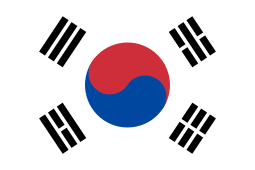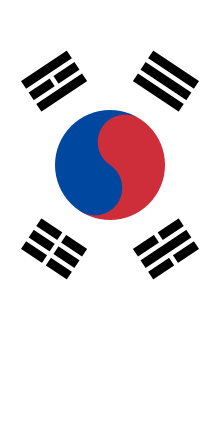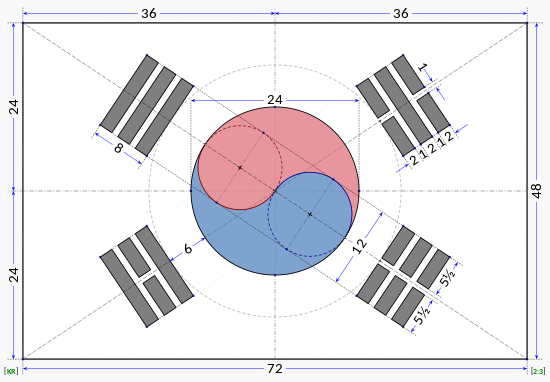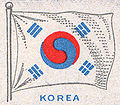
The national flag of the Democratic People's Republic of Korea, also known as the Ramhongsaek Konghwagukgi, consists of a central red panel, bordered both above and below by a narrow white stripe and a broad blue stripe. The central red panel bears a five-pointed red star within a white circle near the hoist.

Joseon, officially Great Joseon State, was a dynastic kingdom of Korea that lasted just over 500 years. It was founded by Taejo of Joseon in July 1392 and replaced by the Korean Empire in October 1897. The kingdom was founded following the aftermath of the overthrow of Goryeo in what is today the city of Kaesong. Early on, Korea was retitled and the capital was relocated to modern-day Seoul. The kingdom's northernmost borders were expanded to the natural boundaries at the rivers of Amnok and Tuman through the subjugation of the Jurchens.
In Chinese philosophy, a taijitu is a symbol or diagram representing taiji in both its monist (wuji) and its dualist forms in application as a deductive and inductive theoretical model. Such a diagram was first introduced by Neo-Confucian philosopher Zhou Dunyi of the Song Dynasty in his Taijitu shuo (太極圖說).

Taegukgi: The Brotherhood of War is a 2004 South Korean war film directed by Kang Je-gyu. It stars Jang Dong-gun and Won Bin and tells the story of two brothers who are forcibly drafted into the South Korean army at the outbreak of the Korean War.

Taegeuk is a Sino-Korean term meaning "supreme ultimate", although it can also be translated as "great polarity / duality". The term and its overall concept is derived from the Chinese Taiji popularised in the west as the Yin and Yang. The symbol was chosen for the design of the Korean national flag in the 1880s. It substitutes the black and white color scheme often seen in most taijitu illustrations with blue and red, respectively, along with a horizontal separator, as opposed to vertical.

The National Emblem of the Republic of Korea consists of the taegeuk symbol present on the South Korean national flag surrounded by five stylized petals and a ribbon bearing the inscription of the official Korean name of the country, in Korean characters. The Taegeuk represents peace and harmony. The five petals all have meaning and are related to South Korea's national flower, the Hibiscus syriacus, or Rose of Sharon.
The Korean terms hyeong, pumsae, poomsae and teul are all used to refer to martial arts forms that are typically used in Korean martial arts such as Taekwondo and Tang Soo Do.
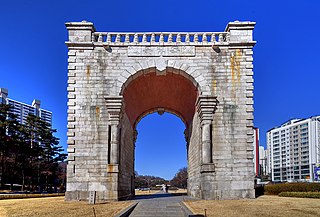
Independence Gate or Dongnimmun is a memorial gate in Seoul, South Korea. It was built in January 1898. Its construction was planned by Soh Jaipil, as a symbol of Korea's commitment to independence. It was designated as a Historic Site of South Korea in 1963, and relocated 70 metres (230 ft) northwest from the original location in 1979 for preservation.
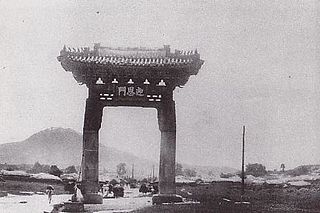
Yeongeunmun or Yeongeunmun Gate was a Joseon-era former gate near present day Seoul, South Korea. Since it was a symbol of China's diplomatic influence on the Joseon, the Gaehwa Party of the Joseon government intentionally demolished it in February 1895, seeking for complete political independence of Joseon from China.
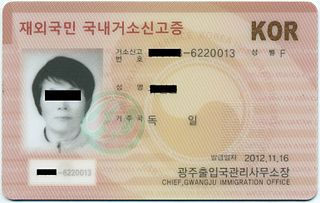
Korean citizens are issued a national ID card when they reach the age of 17. This card contains a unique Resident registration number. The first six numbers indicate the citizen's date of birth, in the format YYMMDD, for example, someone born on August 15, 1980, would have 800815 as the first six digits. The last seven numbers includes information such as where the birth was registered. This resident registration number is used by Korean citizens and foreign nationals for all forms of record-keeping.

The history of Sino-Korean relations dates back to prehistoric times.
Taegeuk Il Jang is the first of eight taekwondo forms practiced in Kukki Taekwondo, as defined by the Kukkiwon. A form, or poomsae, is a choreographed pattern of defense-and-attack motions. Taegeuk Il Jang is considered a beginner form, often practiced by students of Kukki style taekwondo with rank of 8th geup. Eighth geup students of Kukki-style taekwondo practice this form in order to advance to the next rank.
Taegeuk Ee Jang is the second of eight taekwondo forms practiced by the Kukkiwon and the World Taekwondo Federation. A form, or poomsae, is a choreographed pattern of defense-and-attack motions. Taegeuk Ee Jang is considered a beginner form, often practiced by students of Kukkiwon/WTF-style taekwondo with rank of 7th geup. Seventh geup students of Kukkiwon/WTF-style taekwondo practice this form in order to advance to the next rank.
Taegek Sam Jang is the third of eight taekwondo forms practiced by the Kukkiwon and the World Taekwondo Federation. A form, or poomsae, is a choreographed pattern of defense-and-attack motions. Taegeuk Sam Jang is often practiced by students of Kukkiwon/WTF-style taekwondo with rank of 6th geup. Sixth geup students of Kukkiwon/WTF-style taekwondo practice this form in order to advance to the next rank.
Taegek Sa Jang is the fourth of eight taekwondo forms practiced by the Kukkiwon and World Taekwondo. A form, or poomsae, is a choreographed pattern of defense-and-attack motions. Taegeuk Sa Jang is often practiced by students of Kukkiwon/WT-style taekwondo.
Taegeuk Oh Jang is the fifth of eight taekwondo forms in the Taegeuk set practiced by the Kukkiwon and World Taekwondo. A form, or poomsae, is a choreographed pattern of defense-and-attack motions. Taegeuk Oh Jang is often practiced by students of Kukkiwon/WT-style taekwondo with rank of 4th geup. Fourth geup students of Kukkiwon/WTF-style taekwondo practice this form in order to advance to the next rank.
Taegeuk Yook Jang is the sixth of eight taekwondo forms practiced by the Kukkiwon and the World Taekwondo Federation. A form, or poomsae, is a choreographed pattern of defense-and-attack motions. Taegeuk Yook Jang is often practiced by students of Kukkiwon/WTF-style taekwondo with rank of 3rd geup. Third geup students of Kukkiwon/WTF-style taekwondo practice this form in order to advance to the next rank.
Taegeuk Pal Jang is the last of eight taegeuk taekwondo forms practiced by the Kukkiwon and the World Taekwondo Federation. A form, or poomsae, is a choreographed pattern of defense-and-attack motions. Taegeuk Pal Jang is often practiced by students of Kukkiwon/WTF-style taekwondo with rank of 1st geup. First geup students of Kukkiwon/WTF-style taekwondo practice this form in order to advance to the next rank, at which students then begin studying a new sequence of black belt forms.

The Taegeukgi rallies, also known as the Pro-Park rallies (Korean: 친박집회), are ongoing rallies that initially started as a series of counter-candlelight rallies supporting the former president of South Korea Park Geun-hye in 2016 but now continuing with the aim of releasing Park. The Taegeukgi protestors or the Taegeukgi crowds got their names because they vehemently swung or wore South Korean flags during rallies.
The 2019 South Korean Capitol attack occurred on December 16, 2019, when supporters of the Liberty Korea Party, Our Republican Party, and Taegeukgi units attempted to enter the Korea National Assembly Proceeding Hall.
 Joseon dynasty naval ensign
Joseon dynasty naval ensign taegukgi by Park Yeong-hyo (September 1882)
taegukgi by Park Yeong-hyo (September 1882) taegukgi (March 1883). The Qing diplomatic book Tōngshāng Zhāngchéng Chéng'àn Huìbiān (通商章程成案彙編), edited by Li Hongzhang. "The flag of Goryeo belonging to the Great Qing" is written in Chinese characters. Joseon was often called 'Goryeo' in China.
taegukgi (March 1883). The Qing diplomatic book Tōngshāng Zhāngchéng Chéng'àn Huìbiān (通商章程成案彙編), edited by Li Hongzhang. "The flag of Goryeo belonging to the Great Qing" is written in Chinese characters. Joseon was often called 'Goryeo' in China. flag of the Korean Empire (1897–1910)
flag of the Korean Empire (1897–1910) imperial standard of the Korean Empire (1897–1910)
imperial standard of the Korean Empire (1897–1910) a flag made by Ahn Jung-Geun, a Korean independence activist who died in 1910. "大韓獨立(The independence of Greater Korea)" is written.
a flag made by Ahn Jung-Geun, a Korean independence activist who died in 1910. "大韓獨立(The independence of Greater Korea)" is written. flag of the Provisional Government of the Republic of Korea used in 1919 during the March 1st Movement
flag of the Provisional Government of the Republic of Korea used in 1919 during the March 1st Movement  flag of the Provisional Government of the Republic of Korea from 1919 to 1948 used in exile in China
flag of the Provisional Government of the Republic of Korea from 1919 to 1948 used in exile in China  flag of the People's Republic of Korea from August 1945 until December 1945, when the USAMGIK outlawed the PRK
flag of the People's Republic of Korea from August 1945 until December 1945, when the USAMGIK outlawed the PRK the flag of the United States used during the U.S. military occupation of the southern part of Korea from 1945–1948
the flag of the United States used during the U.S. military occupation of the southern part of Korea from 1945–1948 taegukgi used by the United States Army Military Government in Korea from 1945 to 1948
taegukgi used by the United States Army Military Government in Korea from 1945 to 1948